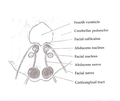Corticomesencephalic tract
| Corticomesencephalic tract | |
|---|---|
 The picture shows Brodmann's area 8, the origin of the corticomesencephalic tract | |
 The picture shows the nuclei of the oculomotor and trochlear nerves, the locations where the fibers of the corticomesencephalic tract terminate. | |
| Details | |
| Identifiers | |
| Latin | tractus corticomesencephalis |
| Anatomical terms of neuroanatomy | |
In neuroanatomy, corticomesencephalic tract is a descending nerve tract that originates in the frontal eye field (Brodmann area 8) and terminate in the midbrain. Its fibers mediate conjugate eye movement.[1]
Structure
The corticomesencephalic tract originates from the frontal eye field in the
Function
The fibers of the corticomesencephalic tracts are involved in the control of the conjugate eye movement. The fibers to the oculomotor (III) nucleus control the medial rectus, superior rectus, inferior rectus, and inferior oblique muscles. Fibers to the trochlear (IV) nucleus control the superior oblique muscle. Fibers to the paramedian pontine reticular formation (PPRF) project to the abducens (VI) nucleus, which controls the movement of the lateral rectus muscle. Also, fibers to the paramedian pontine reticular formation mediates the movements with the oculomotor (III) and trochlear (IV) nerves through the medial longitudinal fasciculus (MLF).[2] The MLF coordinates the interaction between the oculomotor (III) and the abducens (VI) nuclei, which create bilateral conjugate horizontal eye movements.[5]
Additional images
-
Cross section of the midbrain at the level of the superior colliculus showing oculomotor nucleus .
-
Scheme showing central connections of the optic nerves and optic tracts.
-
Cross section of the pons at the level of the facial colliculus. PPRF is not labeled, but is visible adjacent to the abducens nucleus
See also
References
- ISBN 9780198570677.
- ^ ISBN 9781441996534.
- ISBN 9783131644558.
- PMID 4558412.
- PMID 23322826.



